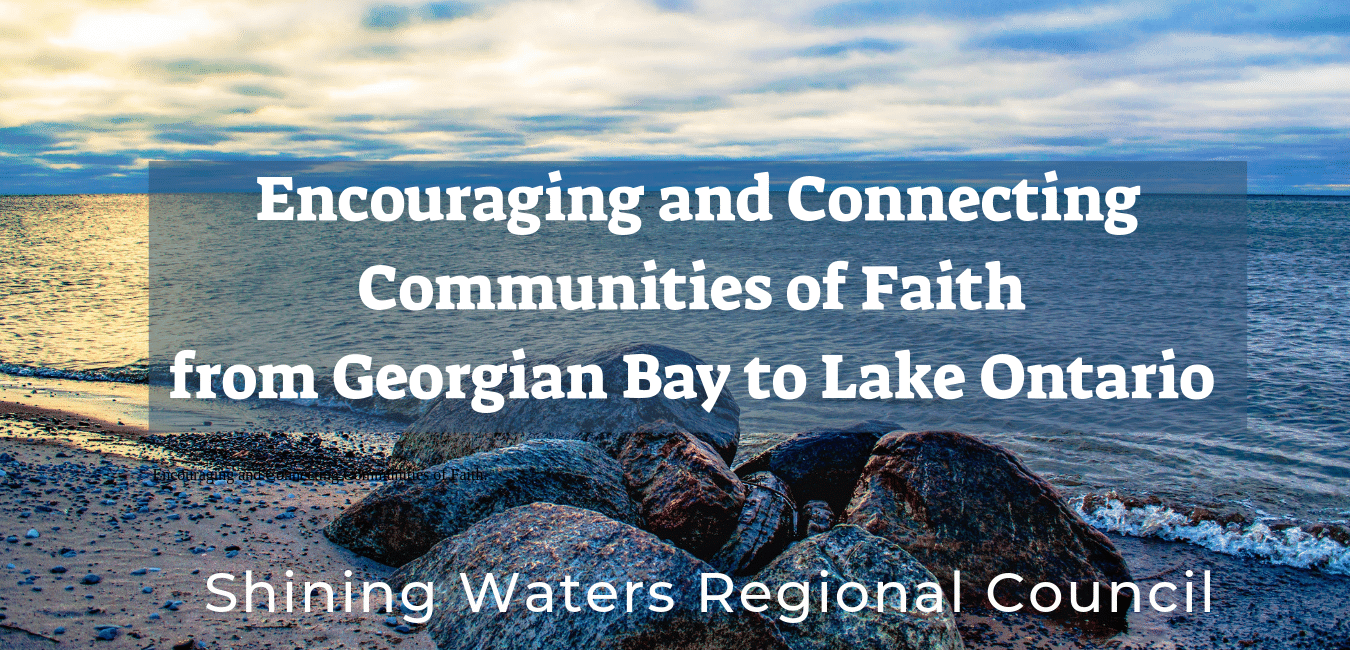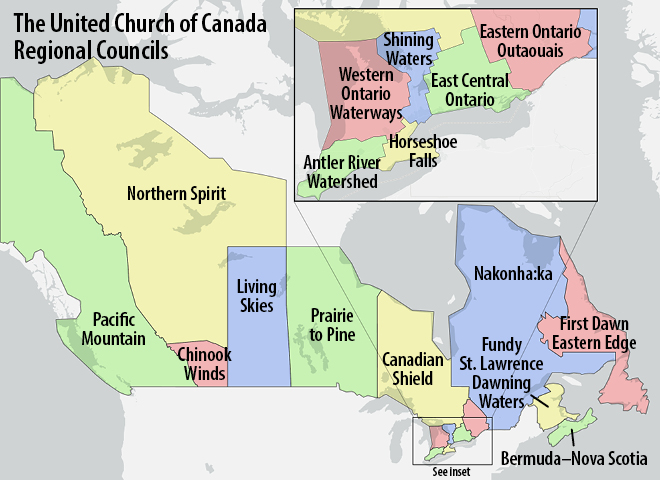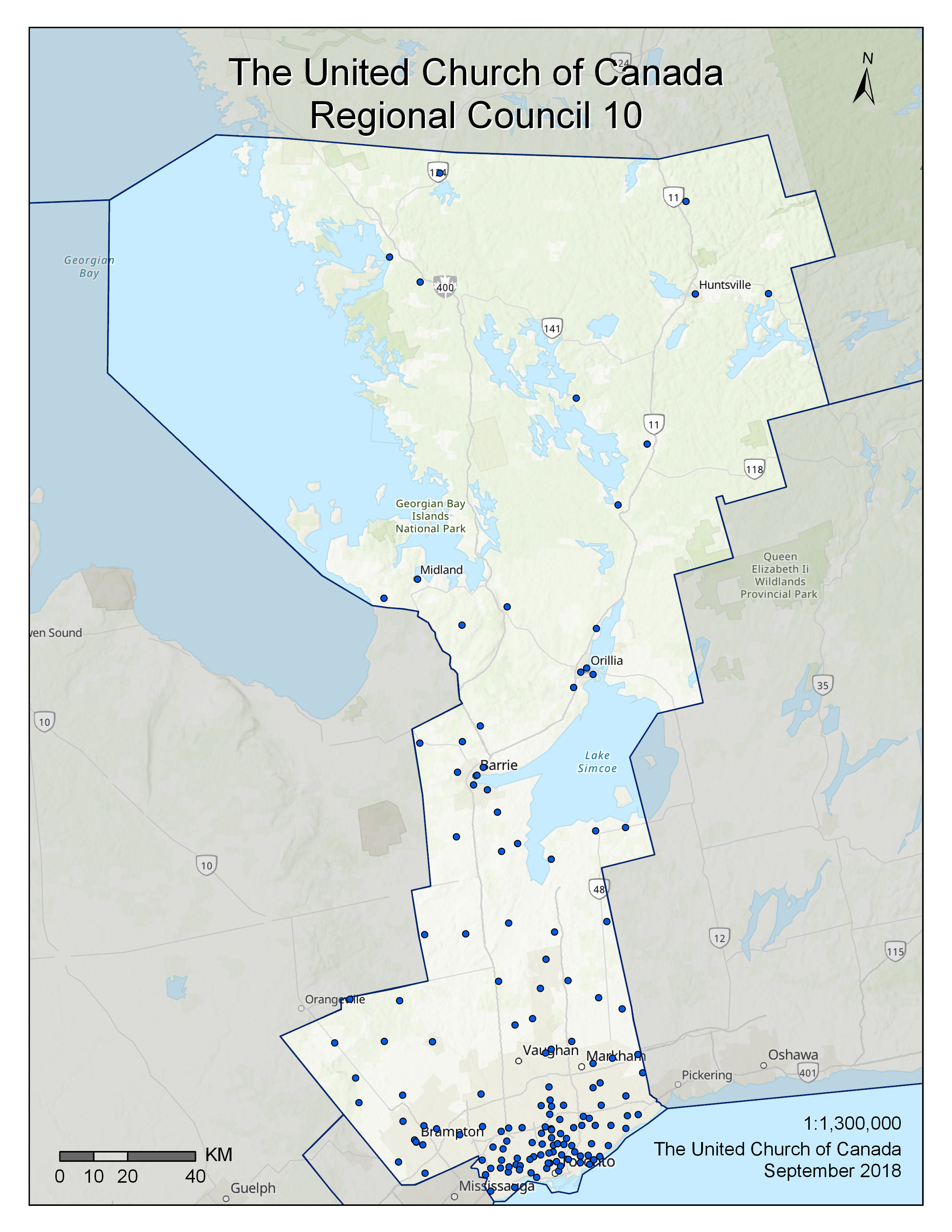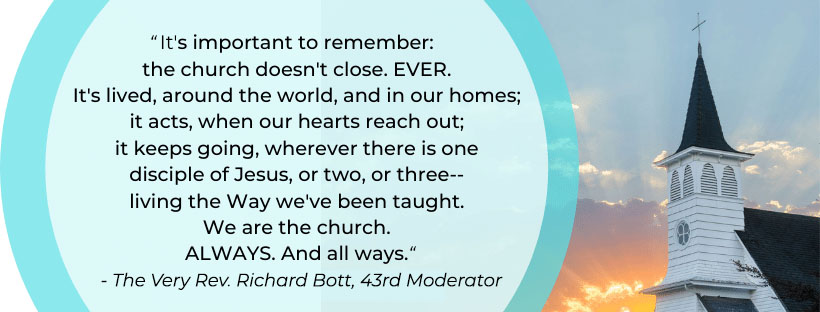
About Us
Shining Waters Regional Council (SWRC) is one of 16 administrative groupings in The United Church of Canada, replacing former conferences and presbyteries. Shining Waters Regional Council is a decision-making body responsible to serve and support Communities of Faith within its bounds as well as to provide necessary oversight. SWRC is composed of all ministry personnel within its geographic bounds; ministers of denominations within mutual recognition agreements while under appointment or call; and lay members elected by the Communities of Faith, respecting the balance of lay and ministry personnel where possible.
Click here or on the map to see the directory of communities of faith in Shining Waters Regional Council. Get in touch with your region!
Google Map of Shining Waters Regional Council
Use the + and – buttons at the bottom left to zoom in and out. Click on the square at the top right to open a larger map in a new window.
Vision and Mission
The vision of Shining Waters Regional Council is Encouraging and Connecting Communities of Faith. To fulfill this vision, the Regional Council and the Regional Council Executive will encourage and engage in:
- joining our collective hearts, voices, and resources to witness to the gospel and vision of Jesus for a compassionate and just society, both in Canada and around the world;
- local, regional, national, and global initiatives and partnerships (community, ecumenical, and interfaith) for ministry, mission, and justice work;
- ministry with children, youth, and young adults;
- honouring and living into intercultural mission and ministry;
- living in covenant with Mother Earth and All My Relations in the Earth community.
Territorial Acknowledgment
We are situated upon traditional territories of the Wendat, the Anishinabek Nation, the Haudenosaunee Confederacy, the Mississaugas of the Credit First Nation, and the Métis Nation. This area is subject to the Dish With One Spoon Wampum Belt Covenant, an agreement to peaceably share and care for the resources around the Great Lakes region.
For more information about territorial acknowledgements please see our Right Relations section of our website.
There is a map and more information on the more than 40 treaty and land agreements in Ontario on the provincial government treaty website https://www.ontario.ca/page/map-ontario-treaties-and-reserves.
Frequently Asked Questions

What is a Regional Council?
As of January 1, 2019, The United Church of Canada adopted a three-council structure, consisting of communities of faith, regional councils and a denominational council. Shining Waters Regional Council is one of 16 regional councils in The United Church of Canada, replacing former conferences and presbyteries. Learn more about The United Church of Canada on their website.A regional council is an administrative grouping of communities of faith in a local area. Laypeople and ministers meet to oversee the work of the church within each region. Laypeople and ministers meet to oversee the work of the church within each region. The regional council is responsible for appointing an executive to do the continuing work of the regional council between regular meetings. For a full description of the polity of regional councils see The United Church of Canada 2025 Manual [PDF – 200 pages] – See page 37 – IV Regional Councils
What are the Boundaries of the Regional Council?
Our northern most point is Knox United Church in Dunchurch just north of Parry Sound; our southernmost points are Alderwood United Church and Beach United Church along the north shores of Lake Ontario; furthest west we are Knox United Church in Caledon; and to the east Knox United Church in Dorset marks our boundary.

What is the membership of the Regional Council?
The Regional Council consists of members of the order of ministry, other ministry personnel, lay members of the United Church, and leaders of associate member ministries, all as set out in The Manual C.1.1 to C.1.3. The president and secretary of the regional United Church Women or their designates will be members of the Regional Council. The Region has power / authority to add members to the Regional Council.
What is the basis of quorum for the Regional Council?
The Regional Council may meet only if a minimum number of members is present. (The Manual C.4.3) For meetings of the Regional Council:
- If there are 60 or more members, at least 20 members must be present; and there must be at least one ministry personnel and one lay member who is not ministry personnel present.
- Corresponding members are not counted for this purpose.
- The executive may make a recommendation to the Regional Council in 2020 regarding quorum.
What are the responsibilities of a Regional Council with respect to candidates for ministry?
The Regional Council is responsible for: celebrating the approval of applicants for candidacy; ordaining and commissioning members of the order of ministry; recognizing designated lay ministers; and celebrating admissions and re-admissions. (The Manual C.2.7)
For more information about the process for entering ministry in The United Church of Canada please see their Candidacy Pathway page. To find out more about our Pastoral Relations please see our webpage section.
Elected Lay Representatives
How are Lay Representatives Elected to the Regional Council?
Communities of faith that are congregations or pastoral charges continue to elect representatives to the regional council in the same way they elected representatives to the presbytery prior to January 1, 2019. They may also change the way in which they elect representatives within denominational policies, with the agreement of the regional council, and by including it in the covenant between the community of faith and regional council.
The lay members of the regional council are members of the United Church who are not ministry personnel and who are:
a) elected by communities of faith on the following basis:
- i) one representative from each community of faith with 100 or fewer members;
- ii) two representatives from each community of faith with 101 to 200 members;
- iii) three representatives from each community of faith with 201 to 300 members;
- iv) four representatives from each community of faith with more than 300 resident members; and
b) additional lay members as determined by the regional council if necessary to respect a balance of ministry personnel and lay members who are not ministry personnel in the membership of the regional council.
What are the responsibilities of Lay Representatives to the Regional Council?
- Lay Representatives have the following responsibilities to their community of faith:
- You are the primary communication hub between the Regional Council and your community of faith.
- Share emails you receive about the work of Regional Council widely in your congregation.
- Share written reports about Regional Council work with the governing body of your community of faith on a regular basis, even if you are not a members of the governing body.
- Write an annual report for the Annual Report of your community of faith.
- Help people in your community of faith know who they should talk to in the regional council about their questions/concerns/need for information.
Read the full Lay Representative Job Description.
For more information on Elected Regional Lay Representatives, please see our Lay Reps page.

